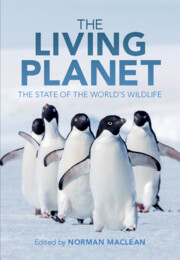Book contents
- The Living Planet
- The Living Planet
- Copyright page
- Contents
- Contributors
- Preface
- Acknowledgements
- One Introduction and the Evolution of Life on Earth
- Two Flowering Plants
- Three Bryophytes and Pteridophytes: Spore-Bearing Land Plants
- Four Terrestrial Mammals
- Five Marine Mammals: Exploited for Millennia, But Still Holding On
- Six How Birds Reveal the Scale of the Biodiversity Crisis
- Seven Reptiles
- Eight Amphibians
- Nine Freshwater Fishes: Threatened Species and Threatened Waters on a Global Scale
- Ten The Amazing Yet Threatened World of Marine Fishes
- Eleven Insects
- Twelve Marine Invertebrates
- Thirteen Non-Insect Terrestrial Arthropods
- Fourteen Terrestrial Invertebrates Other Than Arthropods and Molluscs
- Fifteen Non-Marine Molluscs
- Sixteen An Account of the Diversity and Conservation of Fungi and Their Close Relatives
- Seventeen Simple Life Forms
- Eighteen Assessing Species Conservation Status: The IUCN Red List and Green Status of Species
- Nineteen Problems with the World’s Ecosystems: The Future and Attempts to Mitigate Decline
- Twenty Conservation Methods and Successes
- Twenty One What Does the Future Hold for Our Planet and its Wildlife?
- Species Index
- Subject Index
- References
Nine - Freshwater Fishes: Threatened Species and Threatened Waters on a Global Scale
Published online by Cambridge University Press: 13 April 2023
- The Living Planet
- The Living Planet
- Copyright page
- Contents
- Contributors
- Preface
- Acknowledgements
- One Introduction and the Evolution of Life on Earth
- Two Flowering Plants
- Three Bryophytes and Pteridophytes: Spore-Bearing Land Plants
- Four Terrestrial Mammals
- Five Marine Mammals: Exploited for Millennia, But Still Holding On
- Six How Birds Reveal the Scale of the Biodiversity Crisis
- Seven Reptiles
- Eight Amphibians
- Nine Freshwater Fishes: Threatened Species and Threatened Waters on a Global Scale
- Ten The Amazing Yet Threatened World of Marine Fishes
- Eleven Insects
- Twelve Marine Invertebrates
- Thirteen Non-Insect Terrestrial Arthropods
- Fourteen Terrestrial Invertebrates Other Than Arthropods and Molluscs
- Fifteen Non-Marine Molluscs
- Sixteen An Account of the Diversity and Conservation of Fungi and Their Close Relatives
- Seventeen Simple Life Forms
- Eighteen Assessing Species Conservation Status: The IUCN Red List and Green Status of Species
- Nineteen Problems with the World’s Ecosystems: The Future and Attempts to Mitigate Decline
- Twenty Conservation Methods and Successes
- Twenty One What Does the Future Hold for Our Planet and its Wildlife?
- Species Index
- Subject Index
- References
Summary
Worldwide, freshwater biodiversity is in decline and increasingly threatened. Fishes are the best-documented indicators of this decline. General threats to persistence include: (1) competition for water, (2) habitat alteration, (3) pollution, (4) invasions of alien species, (5) commercial exploitation and (6) global climate change. Regional faunas usually face multiple, simultaneous causes of decline. Threatened species belong to all major evolutionary lineages of fishes, although families with the most imperilled species are those with the most species (e.g. Cyprinidae, Cichlidae). Independent evaluation of California’s highly endemic (81%) fish fauna for comparison with IUCN results validates the alarm generated by IUCN evaluations. However, IUCN overall evaluation is conservative, because it does not include many intraspecific taxa for which extinction trends are roughly double those at the species level. Dramatic global loss of freshwater fish species is imminent without immediate and bold actions by multiple countries.
- Type
- Chapter
- Information
- The Living PlanetThe State of the World's Wildlife, pp. 177 - 205Publisher: Cambridge University PressPrint publication year: 2023



